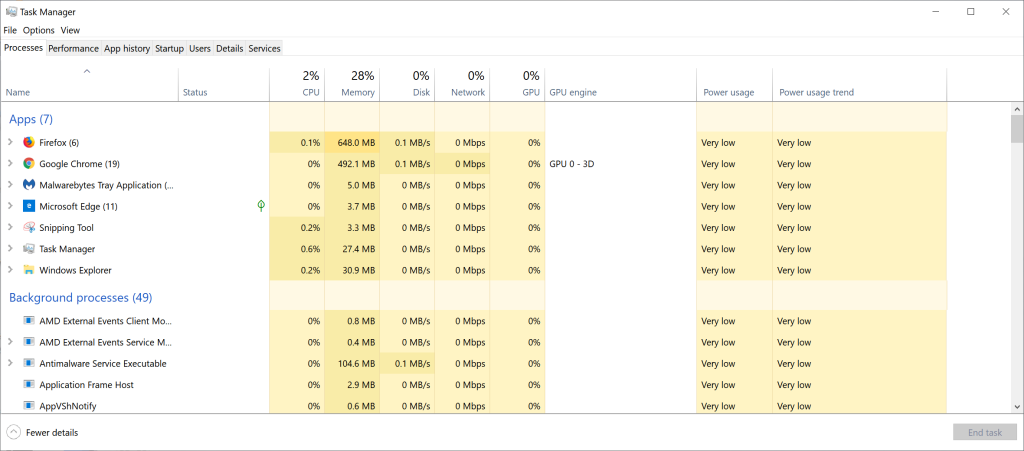Table of Contents
Experience says....
It has been a couple of years since the Help Center started replacing HD with SSD, as a common practice, to resolve performance and/or broken HD issues. The results have been good, given I have not had anyone come back and indicate the result was not acceptable. Recently, while observing “updated, newer, faster” machines with Windows Task Manager, there are indications Microsoft and other software vendors have chosen to use your computer as a source of data and information and sometimes that collection process degrades the performance of your computer. My opinion… Older and and probably slower computers are more heavily impacted by unnecessary data collection and communication. Some of the processes that collect and forward your data (over the internet) can be turned off. There are at least two tools that can “turn off” some of the Microsoft data collection.
One is known as TronScript. Tronscript has a lot of options and functionality. My recommendation… Do not use TronScript unless you are willing to read and understand the script. The heart of TronScript is written in Windows Shell.
An alternative is the set of scripts from Chris Titus. The scripts from Chris might be considered “pieces of Tronscript”. The Chris Titus scripts are written in Windows Power Shell. There is a video about the scripts. Update: July 22, 2022 : Chris Titus has evolved/improved the tool for Windows. Reference this: Chris Titus, ultimate. Be CAREFUL, this tool has a lot of features!!
Using either of the scripts mentioned above implies the need to use a “cmd” window or a “power shell” window. BE CAREFUL!.
Analysis
Slow PC is a symptom with many causes. Determining why the PC is slow, requires analysis. The past few years of experience indicates….. Most of the time, bad performance is accompanied by a very busy HD ( hard drive).
If the PC will get to the point of letting you log in, then the next step might be:
Observe what the PC is doing with the Task Manager. The Task Manager is like the dash board of a car. It can indicate what part of the PC is overheating or running low on resources. Here is another reference for Windows Task Manager.
If you need to “drill down” or develop a deeper understanding of a single program, the Windows Resource Monitor, offers additional features.
Things the Help Center volunteers frequently discover with the Task Manager are:
- Multiple instances of antivirus programs. Typically they all want to do similar activities at system boot time, and the result is a lot of resource consumption that degrades the user experience. The typical solution is: uninstall the extra antivirus programs.
- The system is configured to invoke/start unnecessary programs at system boot. The solution. Disable the unnecessary programs at boot time. One tool that facilitates this action is the autoruns program from Sysinternals.com.
- The Windows Task Manager also has a Tab labeled Startup, that allows enabling and disabling programs that start at boot time.
- The HD ( hard drive) stays very busy (100%) for several minutes after restart.
How do you invoke the Task Manger?
Here are 4 options for starting the Task Manager.
- Right-click the Taskbar and click on Task Manager.
- Open Start, do a search for Task Manager and click the result.
- Use the Ctrl Shift Esc keyboard shortcut.
- Use the Ctrl Alt Del keyboard shortcut and click on Task Manager.
Now What?
You should see something like this:

Make sure the “Process” tab is selected. Now you should see columns for CPU, Memory, Disk and Network. If the system is SLOW then one of those columns probably indicate something close to 100%. A system that is not exhibiting slow behavior, usually indicates values below 10% for CPU and DISK. It is not uncommon for just a couple of programs to be contributing to high utilization of CPU or Disk.
Tell Task Manager to sort on CPU or Disk
Clicking on the CPU column will sort the columns based on CPU utilization. The process using the most CPU resource will be at the top of the list. Clicking on the column again will reverse the sort order.
Clicking on the Disk column will sort the columns based on Disk utilization. The Process using the most Disk resource will be at the top of the list. Clicking on the column again will reverse the sort order.
Most performance problems exhibit high disk consumption. Why? HD (Hard Drives) are most often the neck of the funnel, when it comes to getting something done on a computer. There are times when a computer does not have enough memory, and it starts “swapping” to the hard drive, but that is not what we typically see in the Help Center.
Windows Resource Monitor
A next step in developing an understanding of “what is my computer doing” might include Windows Resource Monitor. Resource Monitor can provide more details about what resources an individual process is consuming. If you want to see all the servers that one web page needs, use Resource Monitor. The internet is truly a web on dependencies.
Here is one item about Windows Resource Monitor
References:
Do a Google search for: “troubleshooting with task manager”.
An alternative to Windows Task Manager is Sysinternals Process Explorer. Process Explorer has additional features. The Sysinternals Process Monitor utility is a more powerful tool for analyzing “why does my computer boot so slow?”.
Microsoft Software Protection Platform Services
This is an interesting thread at Microsoft… High CPU usage by MSPPS

Discussion